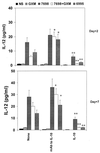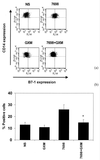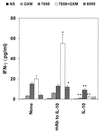Interdependency of interleukin-10 and interleukin-12 in regulation of T-cell differentiation and effector function of monocytes in response to stimulation with Cryptococcus neoformans
- PMID: 11553544
- PMCID: PMC98735
- DOI: 10.1128/IAI.69.10.6064-6073.2001
Interdependency of interleukin-10 and interleukin-12 in regulation of T-cell differentiation and effector function of monocytes in response to stimulation with Cryptococcus neoformans
Abstract
We previously demonstrated that the principal component of capsular material of Cryptococcus neoformans, glucuronoxylomannan (GXM), induces interleukin-10 (IL-10) secretion from human monocytes. Here we report that encapsulation of the yeast with GXM is able to down-regulate interleukin-12 (IL-12) production by monocytes that would normally occur in the absence of encapsulation. This phenomenon appeared to be the result of inhibition of the phagocytic process by encapsulation with GXM as well as of negative signals such as IL-10 secretion produced by interaction of GXM with leukocytes. Decreased secretion of IL-12 correlated with decreased release of gamma interferon (IFN-gamma) from T cells, suggesting a role for encapsulation with GXM in hindering a T helper type 1 (Th1) response. This is supported by the ability of encapsulation with GXM to limit increased expression of B7-1 costimulatory molecules that otherwise might limit IL-10 secretion. Endogenous IL-10 played a critical role in modulatory activity associated with encapsulation with GXM. Blocking IL-10 with monoclonal antibody to IL-10 resulted in increased (i) IL-12 secretion, (ii) IFN-gamma release from T cells, and (iii) killing of C. neoformans by monocytes. These results suggest that encapsulation with GXM limits development of a protective Th1-type response, an inhibitory process in which IL-10 plays a critical role. Scavengers of GXM and/or IL-10 could be useful in a protective Th1-type response in patients with cryptococcosis.
Figures






References
-
- Brossart P, Zobywalski A, Grunebach F, Behnke L, Stuhler G, Reichardt V L, Kanz L, Brugger W. Tumor necrosis factor alpha and CD40 ligand antagonize the inhibitory effects of interleukin 10 on T-cell stimulatory capacity of dendritic cells. Cancer Res. 2000;60:4485–4492. - PubMed
-
- Chang J T, Segal B M, Shevach E M. Role of costimulation in the induction of the IL-12/IL-12 receptor pathway and the development of autoimmunity. J Immunol. 2000;164:100–106. - PubMed
-
- Cherniak R, Reiss E, Slodki M E, Plattner R D, Blumer S O. Structure and antigenic activity of the capsular polysaccharide of Cryptococcus neoformans. Mol Immunol. 1980;17:1025–1032. - PubMed
-
- Cherniak R, Reiss E, Turner S H. A galactoxylomannan antigen of Cryptococcus neoformans serotype A. Carbohydr Res. 1982;103:239–250.
Publication types
MeSH terms
Substances
Grants and funding
LinkOut - more resources
Full Text Sources

